Water-Nutrient Coupling Strategies That Improve the Carbon, Nitrogen Metabolism, and Yield of Cucumber under Sandy Cultivated Land
Abstract
1. Introduction
2. Materials and Methods
2.1. Research Study Area
2.2. Experimental Design
2.3. Data Collection and Measurements
2.4. Enzyme Extracts Preparation and Antioxidant Enzyme Activities
2.5. Statistical Analysis
3. Results
3.1. Soluble Sugar, Soluble Protein, and Actual Leaf Nitrogen Contents
3.2. Acid Invertase Enzyme (AIE), Neutral Invertase Enzyme (NIE), and Nitrate Reductase (NR) Activities
3.3. Glutamate Synthase (GOGAT), Glutamate Dehydrogenase (GLDH), and Glutamine Synthase (GS) Activities
3.4. Sucrose Phosphate Synthase (SPS) and Sucrose Synthase (SS) Activities
3.5. CAT, POD, RuBisCO, and SOD Activities
3.6. Cucumber Yield (t hm-2) and Pearson’s Correlation Coefficients
4. Discussion
5. Conclusions
Author Contributions
Funding
Data Availability Statement
Conflicts of Interest
References
- Cheng, M.; Wang, H.; Fan, J.; Zhang, S.; Liao, Z.; Zhang, F.; Wang, Y. A global meta-analysis of yield and water use efficiency of crops, vegetables and fruits under full, deficit and alternate partial root-zone irrigation. Agric. Water Manag. 2021, 248, 106771. [Google Scholar] [CrossRef]
- Du, T.; Kang, S.; Zhang, J.; Davies, W.J. Deficit irrigation and sustainable water-resource strategies in agriculture for China’s food security. J. Exp. Bot. 2015, 66, 2253–2269. [Google Scholar] [CrossRef]
- Mutambara, S.; Darkoh, M.B.K.; Atlhopheng, J.R. A comparative review of water management sustainability challenges in smallholder irrigation schemes in Africa and Asia. Agric. Water Manag. 2016, 171, 63–72. [Google Scholar] [CrossRef]
- Wei, Z.H.; Du, T.S.; Li, X.N.; Fang, L.; Liu, F.L. Interactive effects of elevated CO and N fertilization on yield and quality of tomato grown under reduced irrigation regimes. Front. Plant Sci. 2018, 9, 328. [Google Scholar] [CrossRef]
- Liu, H.; Li, H.H.; Ning, H.F.; Zhang, X.X.; Li, S.; Pang, J.; Wang, G.S.; Sun, J.S. Optimizing irrigation frequency and amount to balance yield, fruit quality and water use efficiency of greenhouse tomato. Agric. Water Manag. 2019, 226, 105787. [Google Scholar] [CrossRef]
- Liu, H.J.; Yin, C.Y.; Gao, Z.Z.; Hou, L.Z. Evaluation of cucumber yield, economic benefit and water productivity under different soil matric potentials in solar greenhouses in North China. Agric. Water Manag. 2021, 243, 106442. [Google Scholar] [CrossRef]
- Wang, Q.; Men, L.Z.; Gao, L.H.; Tian, Y.Q. Effect of grafting and gypsum application on cucumber (Cucumis sativus L.) growth under saline water irrigation. Agric. Water Manag. 2017, 188, 79–90. [Google Scholar] [CrossRef]
- Chen, W.; Hou, Z.; Wu, L.; Liang, Y.; Wei, C. Evaluating salinity distribution in soil irrigated with saline water in arid regions of northwest China. Agric. Water Manag. 2010, 97, 2001–2008. [Google Scholar] [CrossRef]
- Ali, S.; Xu, Y.; Ma, X.; Ahmad, I.; Kamran, M.; Dong, Z.; Cai, T.; Jia, Q.; Ren, X.; Zhang, P.; et al. Planting models and deficit irrigation strategies to improve wheat production and water use efficiency under simulated rainfall conditions. Front. Plant Sci. 2017, 8, 1408. [Google Scholar] [CrossRef]
- Chen, Z.; Tian, T.; Gao, L.; Tian, Y. Nutrients, heavy metals and phthalate acid esters in solar greenhouse soils in Round-Bohai Bay-Region, China: Impacts of cultivation year and biogeography. Environ. Sci. Pollut. Res. 2016, 23, 13076–13087. [Google Scholar] [CrossRef]
- Cao, C.Y.; Jiang, S.Y.; Zhang, Y.; Zhang, F.X.; Han, X.S. Spatial variability of soil nutrients and microbiological properties after the establishment of leguminous shrub Caragana microphylla Lam. plantation on sand dune in the Horqin Sandy Land of Northeast China. Ecol. Eng. 2011, 37, 1467–1475. [Google Scholar] [CrossRef]
- Cui, Y.; Tian, Z.; Zhang, X.; Muhammad, A.; Han, H.; Jiang, D.; Cao, W.; Dai, T. Effect of water deficit during vegetative growth periods on post-anthesis photosynthetic capacity and grain yield in winter wheat (Triticum aestivum L.). Acta Physiol. Plant. 2015, 37, 196. [Google Scholar] [CrossRef]
- Gupta, A.K.; Kaur, K.; Kaur, N. Stem reserve mobilization and sink activity inwheat under drought conditions. Am. J. Plant Sci. 2011, 2, 70–77. [Google Scholar] [CrossRef][Green Version]
- Sun, Y.; Hu, K.; Fan, Z.; Wei, Y.; Lin, S.; Wang, J. Simulating the fate of nitrogen and optimizing water and nitrogen management of greenhouse tomato in North China using the EU-Rotate_N model. Agric. Water Manag. 2013, 128, 72–84. [Google Scholar] [CrossRef]
- Ran, Y.; Xie, J.; Xu, X.; Li, Y.; Liu, Y.; Zhang, Q.; Li, Z.; Xu, J.; Di, H. Warmer and drier conditions and nitrogen fertilizer application altered methanotroph abundance and methane emissions in a vegetable soil. Environ. Sci. Pollut. Res. 2017, 24, 2770–2780. [Google Scholar] [CrossRef] [PubMed]
- Cao, Q.; Wang, S.Z.; Gao, L.H.; Ren, H.Z.; Chen, Q.Y.; Zhao, J.W.; Wang, Q.; Sui, X.L.; Zhang, Z.X. Effect of alternative furrow irrigation on growth and water us of cucumber in solar greenhouse. Trans. Chin. Soc. Agric. Eng. 2010, 29, 47–53, (In Chinese with English abstract). [Google Scholar]
- Wang, Y.; Jensen, C.R.; Liu, F. Nutritional responses to soil drying and rewetting cycles under partial root-zone drying irrigation. Agric. Water Manag. 2017, 179, 254–259. [Google Scholar] [CrossRef]
- Yu, B.; Yan, S.; Zhou, H.; Dong, R.; Lei, J.; Chen, C.; Cao, B. Overexpression of CsCaM3 improves high temperature tolerance in cucumber. Front. Plant Sci. 2018, 9, 797. [Google Scholar] [CrossRef]
- Fazeli, F.; Ghorbanli, M.; Niknam, V. Effect of drought on biomass, protein content, lipid peroxidation and antioxidant enzymes in two sesame cultivars. Biol. Plant. 2007, 51, 98–103. [Google Scholar] [CrossRef]
- Hou, M.; Jin, Q.; Lu, X.; Li, J.; Zhong, H.; Gao, Y. Growth, water use, and nitrate-15N uptake of greenhouse tomato as influenced by different irrigation patterns, 15N labeled depths, and transplant times. Front. Plant Sci. 2017, 8, 666. [Google Scholar] [CrossRef]
- Lakhdar, A.; Hafsi, C.; Debez, A.; Montemurro, F.; Jedidi, N.; Abdelly, C. Assessing solid waste compost application as a practical approach for salt-affected soil reclamation. Acta Agric. Scand. Sect. B—Soil Plant Sci. 2011, 61, 284–288. [Google Scholar] [CrossRef]
- Lakhdar, A.; Rabhi, M.; Ghnaya, T.; Montemurro, F.; Jedidi, N.; Abdelly, C. Effectiveness of compost use in salt-affected soil. J. Hazard. Mater. 2009, 171, 29–37. [Google Scholar] [CrossRef] [PubMed]
- Lakhdar, A.; Hafsi, C.; Rabhi, M.; Debez, A.; Montemurro, F.; Abdelly, C.; Jedidi, N.; Ouerghi, Z. Application of municipal solid waste compost reduces the negative effects of saline water in Hordeum maritimum L. Bioresour. Technol. 2008, 99, 7160–7167. [Google Scholar] [CrossRef] [PubMed]
- Farooq, M.; Wahid, A.; Kobayashi, N.; Fujita, D.; Basra, S.M. Plant drought stress: Effects, mechanisms and management. Agron. Sustain. Dev. 2009, 29, 185–212. [Google Scholar] [CrossRef]
- Farneselli, M.; Benincasa, P.; Tosti, G.; Simonne, E.; Guiducci, M.; Tei, F. High fertigation frequency improves nitrogen uptake and crop performance in processing tomato grown with high nitrogen and water supply. Agric. Water Manag. 2015, 154, 52–58. [Google Scholar] [CrossRef]
- Huang, Y.; Tang, R.; Cao, Q.; Bie, Z. Improving the fruit yield and quality of cucumber by grafting onto the salt tolerant rootstock under NaCl stress. Sci. Hortic. 2009, 122, 26–31. [Google Scholar] [CrossRef]
- Sharma, D.K.; Andersen, S.B.; Ottosen, C.-O.; Rosenqvist, E. Wheat cultivars selected for high Fv/Fm under heat stress maintain high photosynthesis, total chlorophyll, stomatal conductance, transpiration and dry matter. Physiol. Plant. 2015, 153, 284–298. [Google Scholar] [CrossRef]
- Singh, M.C.; Singh, J.P.; Pandey, S.K.; Mahay, D.; Shrivastva, V. Factors affecting the performance of greenhouse cucumber cultivation-a review. Int. J. Curr. Microbiol. Appl. Sci. 2017, 6, 2304–2323. [Google Scholar] [CrossRef]
- Wang, Z.; Liu, Z.; Zhang, Z.; Liu, X. Subsurface drip irrigation scheduling for cucumber (Cucumis sativus L.) grown in solar greenhouse based on 20 cm standard pan evaporation in Northeast China. Sci. Hortic. 2009, 123, 51–57. [Google Scholar] [CrossRef]
- Fasina, A.; Awe, G.; Ilori, A.; Babalola, T.; Ogunleye, K. Effect of drip irrigation frequency and N-fertilization on yield and water use efficiency of cucumber (Cucumis sativus) in Ado-Ekiti. Niger. Res. Crop. 2021, 22, 292–300. [Google Scholar]
- Blandino, M.; Reyneri, A. Effect of fungicide and foliar fertilizer application to winter wheat at anthesis on flag leaves senescence, grain yield, flour bread-making quality and DON contamination. Eur. J. Agron. 2009, 30, 275–282. [Google Scholar] [CrossRef]
- Tian, Y.; Zhang, X.; Wang, J.; Gao, L. Soil microbial communities associated with the rhizosphere of cucumber under different summer cover crops and residue management: A 4-year field experiment. Sci. Hortic. 2013, 150, 100–109. [Google Scholar] [CrossRef]
- Khan, N.; Bano, A.; Rahman, M.A.; Rathinasabapathi, B.; Babar, M.A. UPLC-HRMS-based untargeted metabolic profiling reveals changes in chickpea (Cicer arietinum) metabolome following long-term drought stress. Plant Cell Environ. 2019, 42, 115–132. [Google Scholar] [CrossRef] [PubMed]
- Ren, X.; Jia, Z.; Chen, X. Rainfall concentration for increasing corn production under semiarid climate. Agr. Water Manag. 2008, 95, 1293–1302. [Google Scholar] [CrossRef]
- Reddy, A.R.; Chaitanya, K.V.; Vivekanandan, M. Drought-induced responses of photosynthesis and antioxidant metabolism in higher plants. J. Plant Physiol. 2004, 11, 15602811. [Google Scholar] [CrossRef] [PubMed]
- He, Z.H.; Li, M.L.; Cai, Z.L.; Zhao, R.; Hong, T.T.; Yang, Z.; Zhang, Z. Optimal irrigation and fertilizer amounts based on multi-level fuzzy comprehensive evaluation of yield, growth and fruit quality on cherry tomato. Agric. Water Manag. 2021, 243, 106360. [Google Scholar] [CrossRef]
- Li, H.S. Principles and Techniques of Plant Physiological Experiment; Higher Education Press: Beijing, China, 2000; pp. 119–120. (In Chinese) [Google Scholar]
- Amalo, K.; Chen, G.X.; Asade, K. Separate assays specific for ascorbate peroxidase and guaiacal peroxidase and for the chloroplastic and cytosolic isozymes of ascorbate peroxidase implants. Plant Cell Physiol. 1994, 35, 497–504. [Google Scholar]
- Tan, W.; Liu, J.; Dai, T.; Jing, Q.; Cao, W.; Jiang, D. Alternations in photosynthesis and antioxidant enzyme activity in winter wheat subjected to post-anthesis water-logging. Photosynthetica 2008, 46, 21–27. [Google Scholar] [CrossRef]
- Wu, Y.; Xi, X.; Tang, X.; Luo, D.; Gu, B.; Lam, S.K.; Vitousek, P.M.; Chen, D. Policy distortions, farm size, and the overuse of agricultural chemicals in China. Proc. Natl. Acad. Sci. USA 2018, 115, 7010–7015. [Google Scholar] [CrossRef]
- Perchlik, M.; Tegeder, M. Leaf amino acid supply affects photosynthetic and plant nitrogen use efficiency under nitrogen stress. Plant Physiol. 2018, 178, 174–188. [Google Scholar] [CrossRef]
- Shi, J.; Yasuor, H.; Yermiyahu, U.; Zuo, Q.; Ben-Gal, A. Dynamic responses of wheat to drought and nitrogen stresses during re-watering cycles. Agric. Water Manag. 2014, 146, 163–172. [Google Scholar]
- Ouyang, Z.; Tian, J.C.; Zhao, C.; Yan, X.F. Coupling model and optimal combination scheme of water, fertilizer, dissolved oxygen and temperature in greenhouse tomato under drip irrigation. Int. J. Agric. Biol. Eng. 2021, 14, 37–46. [Google Scholar]
- Roca, L.F.; Romero, J.; Boh’orquez, J.M.; Alcántara, E.; Fernández-Escobar, R.; Trapero, A. Nitrogen status affects growth, chlorophyll content and infection by Fusicladium oleagineum in olive. Crop Prot. 2018, 109, 80–85. [Google Scholar] [CrossRef]
- Anjum, S.A.; Wang, L.C.; Farooq, M.; Hussain, M.; Xue, L.L.; Zou, C.M. Brassinolide application improves the drought tolerance in maize through modulation of enzymatic antioxidants and leaf gas exchange. J. Agron. Crop Sci. 2011, 197, 177–185. [Google Scholar]
- Kaur, K.; Kaur, N.; Gupta, A.K.; Singh, I. Exploration of the antioxidative defense system to characterize chickpea genotypes showing differential response towards water deficit conditions. Plant Growth Regul. 2013, 70, 49–60. [Google Scholar] [CrossRef]
- Xu, G.; Fan, X.; Miller, A.J. Plant nitrogen assimilation and use efficiency. Annu. Rev. Plant Biol. 2012, 63, 153–182. [Google Scholar]
- Lum, M.S.; Hanafi, M.M.; Rafii, Y.M.; Akmar, A.S.N. Effect of drought stress on growth, proline and antioxidant enzyme activities of upland rice. J. Anim. Plant Sci. 2014, 24, 1487–1493. [Google Scholar]
- Kang, S.Z.; Hao, X.M.; Du, T.S.; Tong, L.; Su, X.L.; Lu, H.N.; Li, X.L.; Huo, Z.L.; Li, S.E.; Ding, R.S. Improving agricultural water productivity to ensure food security in China under changing environment: From research to practice. Agric. Water Manag. 2017, 179, 5–17. [Google Scholar] [CrossRef]
- Valdés, R.; Miralles, J.; Franco, J.A.; Sánchez-Blanco, M.J.; Bañón, S. Using soil bulk electrical conductivity to manage saline irrigation in the production of potted poinsettia. Sci. Hortic. 2014, 170, 1–7. [Google Scholar] [CrossRef]
- Beck, E.H.; Fetitig, S.; Knake, C.; Hartig, K.; Bhattarai, T. Specific and unspecificresponses of plants to cold and drought stress. J. Biosci. 2007, 32, 501–510. [Google Scholar]
- Miller, G.; Suzuki, N.; Ciftci-Yilmaz, S.; Mittler, R. Reactive oxygen species homeostasis and signaling during drought and salinity stresses. Plant Cell Environ. 2010, 33, 453–467. [Google Scholar] [CrossRef]
- Sairam, R.K.; Srivastava, G.C. Water stress tolerance of wheat (Triticum aestivum L.): Variations in hydrogen peroxide accumulation and antioxidant activity in tolerant and susceptible genotypes. J. Agron. Crop Sci. 2001, 186, 63–70. [Google Scholar] [CrossRef]
- Yan, M.F.; Zhang, X.S.; Jiang, Y.; Zhou, G.S. Effects of irrigation and plowing on soil carbon dioxide efflux in a poplar plantation chronosequence in northwest China. Soil Sci. Plant Nutr. 2011, 57, 466–474. [Google Scholar] [CrossRef]
- Fotelli, M.N.; Rennenberg, H.; Gessler, A. Effects of drought on the competitive interference of an early successional species (Rubus fruticosus) on Fagus sylvatica L. seedlings: N-15 uptake and partitioning, responses of amino acids and other N compounds. Plant Biol. 2002, 4, 311–320. [Google Scholar] [CrossRef]
- Abdalhi, M.A.M.; Cheng, J.L.; Feng, S.Y.; Yi, G. Performance of drip irrigation and nitrogen fertilizer in irrigation water saving and nitrogen use efficiency for waxy maize (Zea mays L.) and cucumber (Cucumis sativus L.) under solar greenhouse. Grassl. Sci. 2016, 62, 174–187. [Google Scholar] [CrossRef]
- Li, D.; Dong, J.L.; Gruda, N.S.; Li, X.; Duan, Z.Q. Elevated root-zone temperature promotes the growth and alleviates the photosynthetic acclimation of cucumber plants exposed to elevated [CO2]. Environ. Exp. Bot. 2022, 194, 104694. [Google Scholar] [CrossRef]
- Zhu, Y.; Cai, H.J.; Song, L.B.; Chen, H. Aerated irrigation promotes soil respiration and microorganism abundance around tomato rhizosphere. Soil Sci. Soc. Am. J. 2019, 83, 1343–1355. [Google Scholar] [CrossRef]
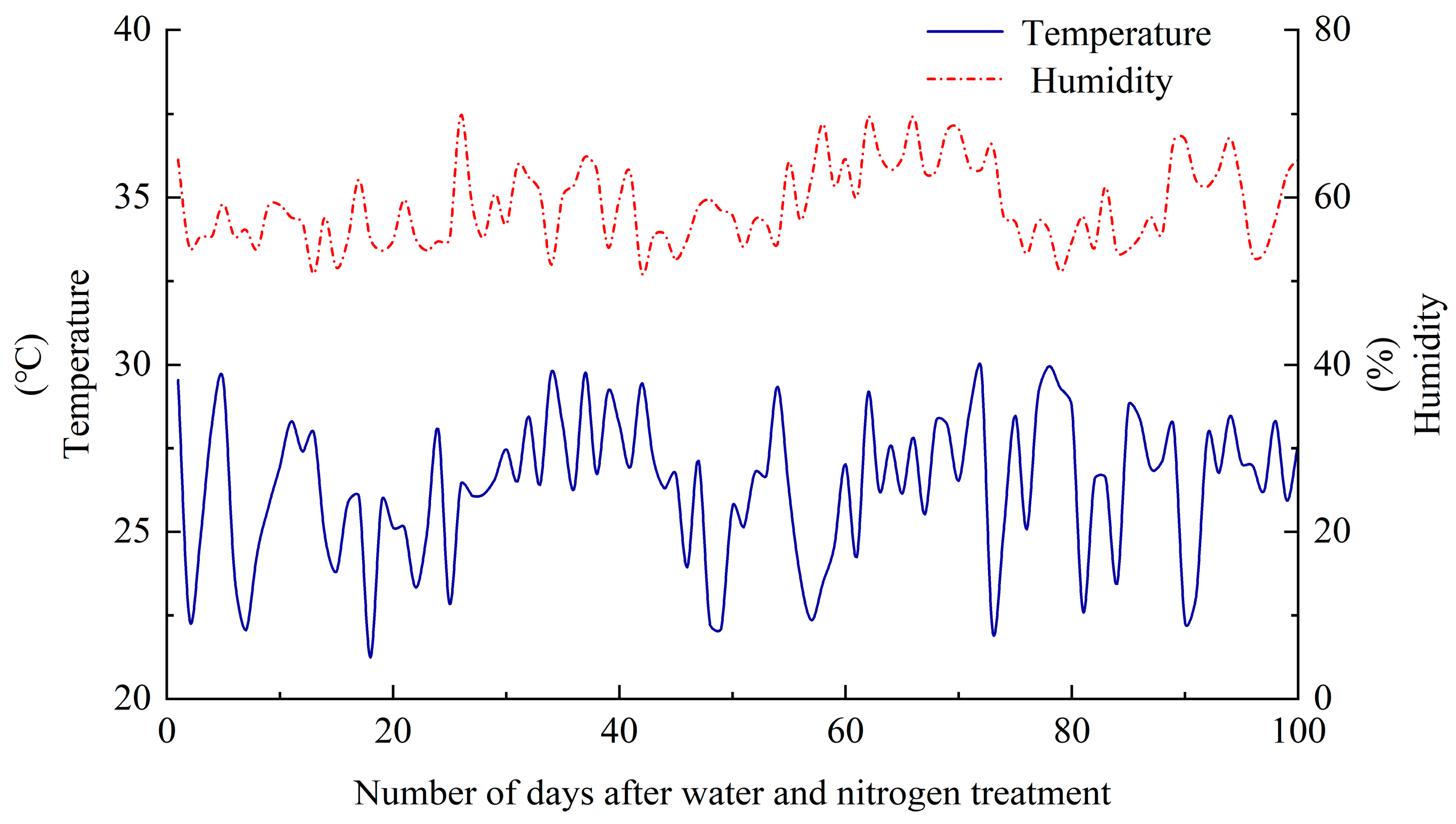
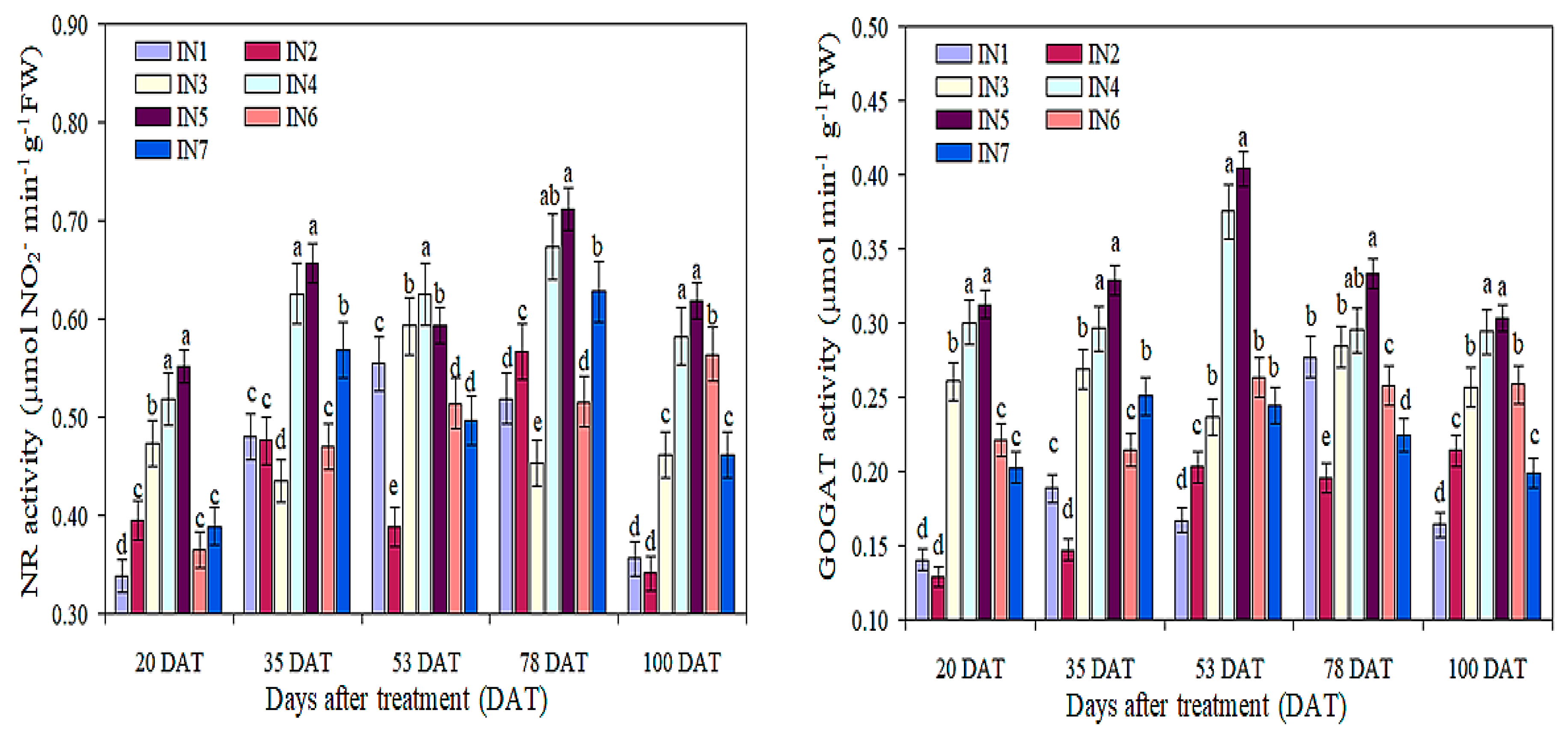
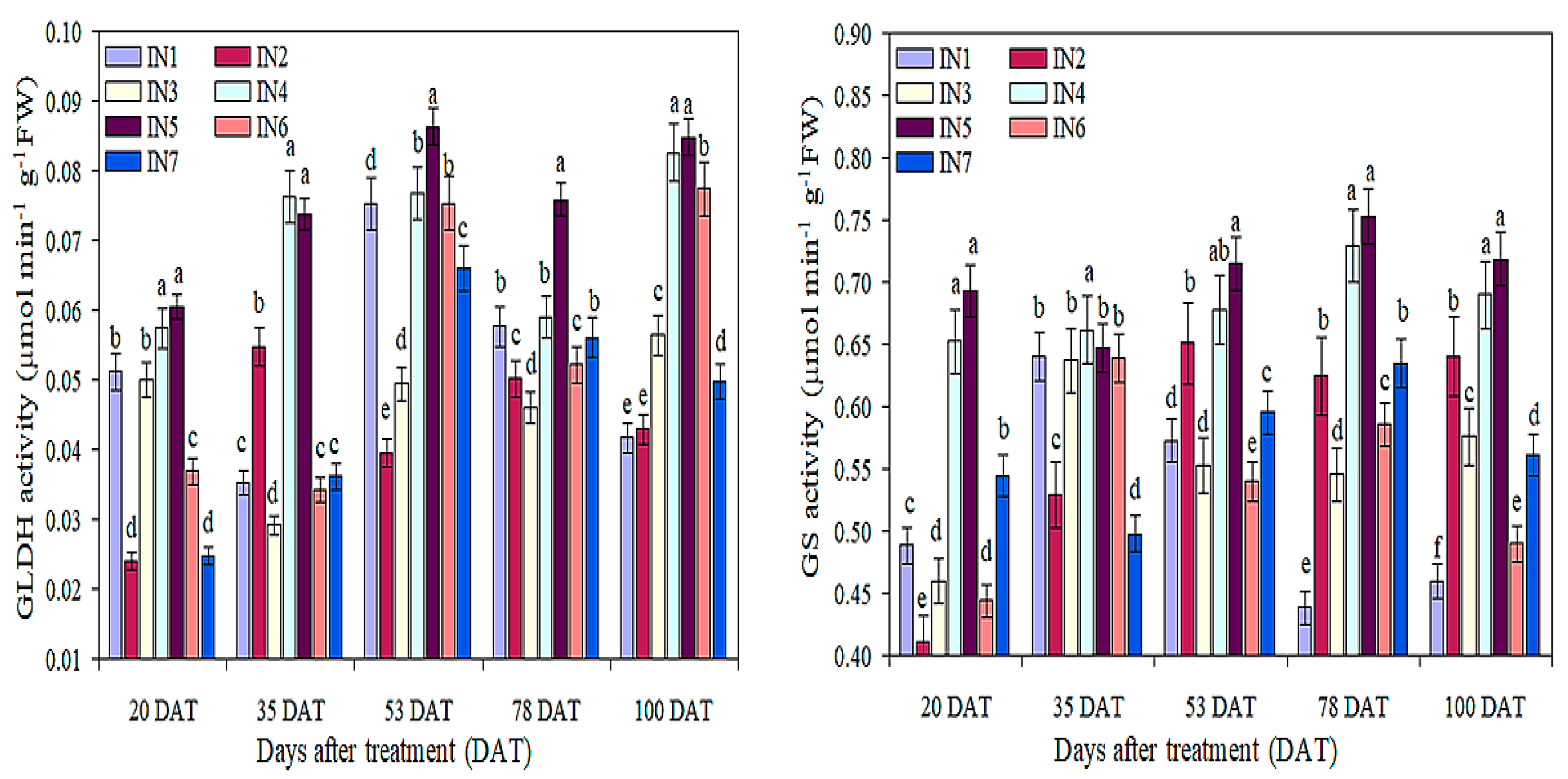

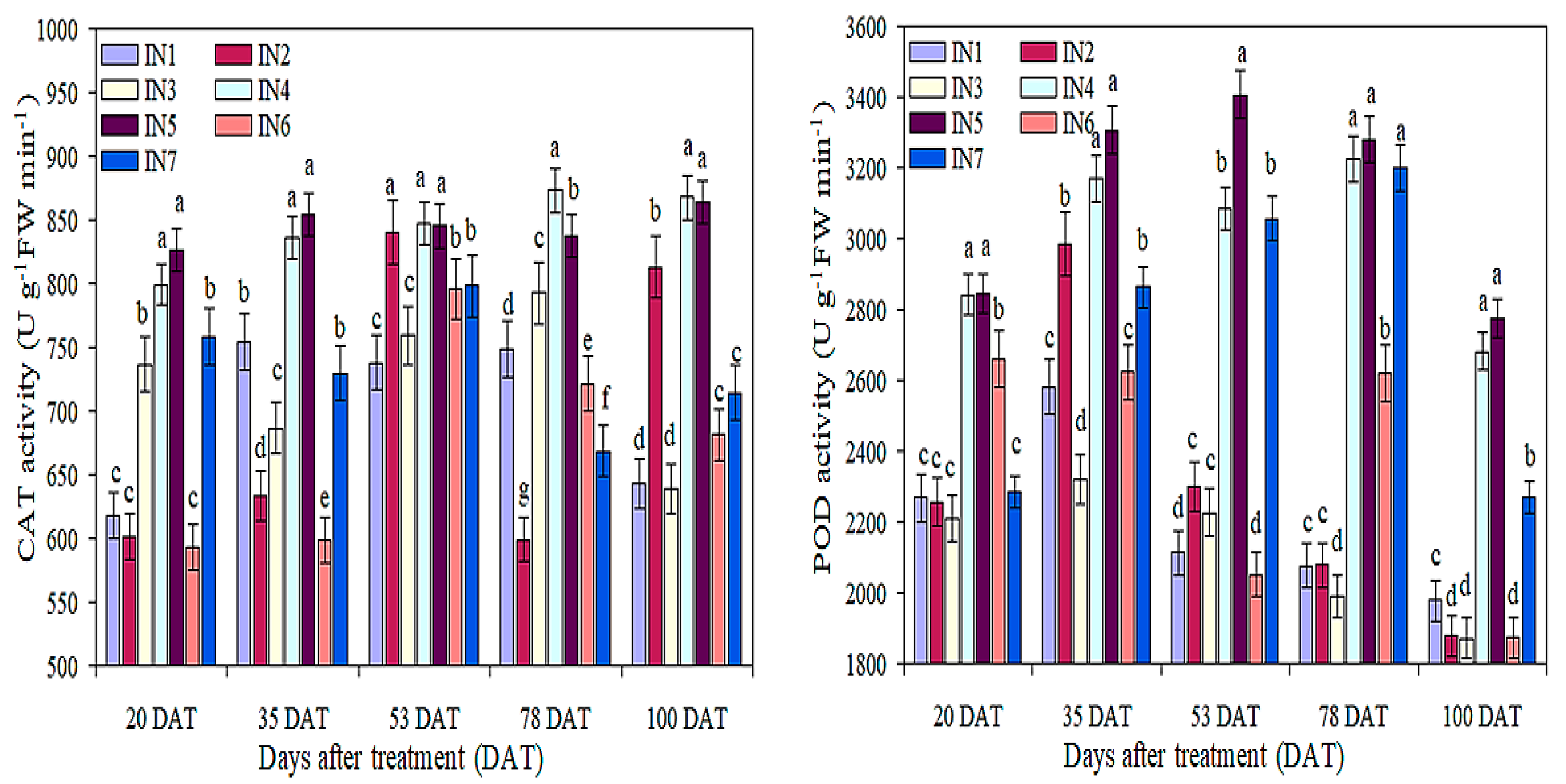
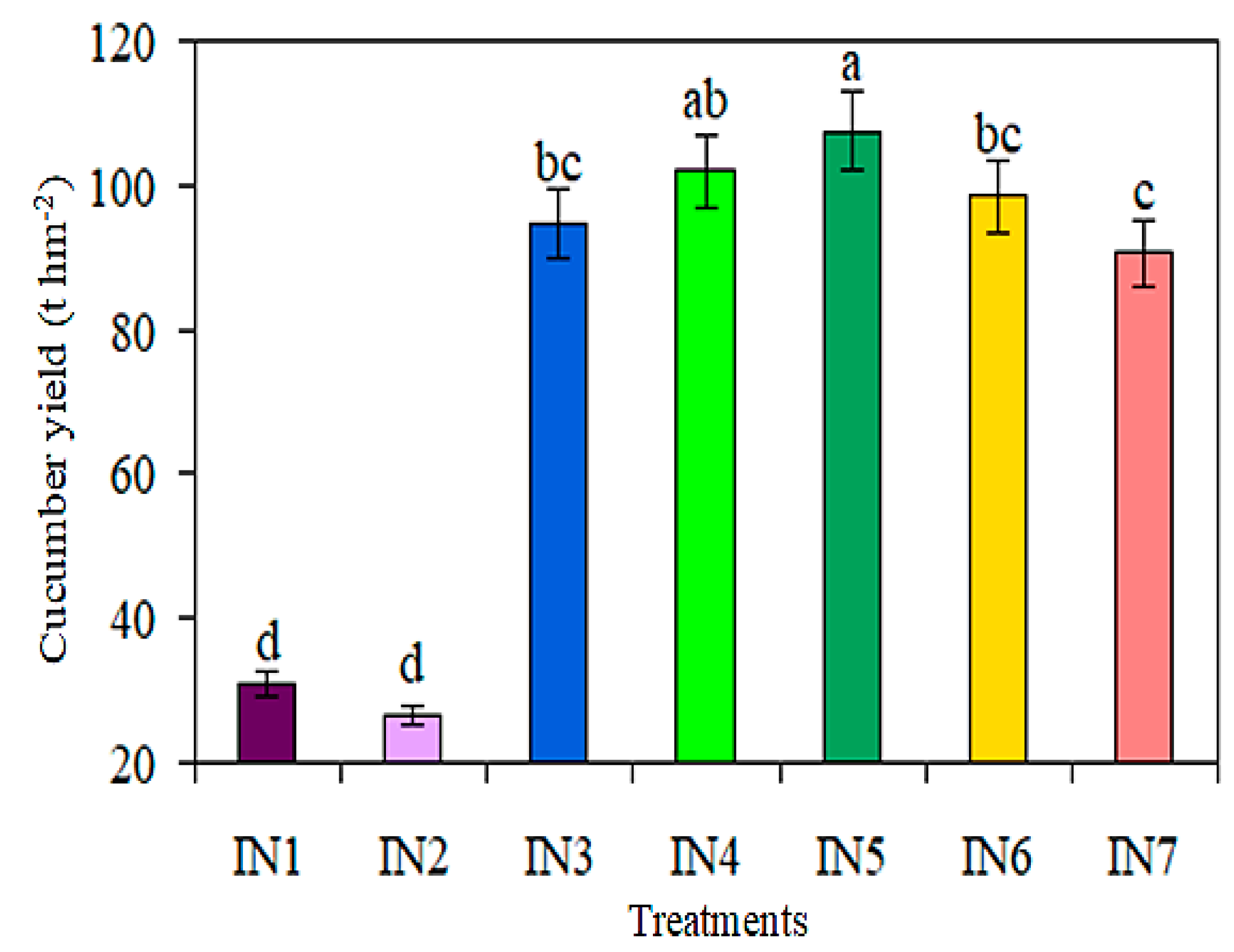
| Treatments | Actual Value | |
|---|---|---|
| Irrigation Level (%) | N Application (kg hm−2) | |
| IN1 | 65 | 150 |
| IN2 | 100 | 150 |
| IN3 | 65 | 1250 |
| IN4 | 80 | 623 |
| IN5 | 89 | 1250 |
| IN6 | 100 | 917 |
| IN7 | 100 | 1250 |
| Treatments | Soluble Sugar Contents (mg g−1 FW) | Soluble Protein Contents (mg g−1 FW) | ||||||||
|---|---|---|---|---|---|---|---|---|---|---|
| Days after Treatment (DAT) | Days after Treatment (DAT) | |||||||||
| 20 DAT | 35 DAT | 53 DAT | 78 DAT | 100 DAT | 20 DAT | 35 DAT | 53 DAT | 78 DAT | 100 DAT | |
| IN1 | 3.5 ± 0.19 b | 4.3 ± 0.14 b | 5.0 ± 0.11 b | 7.7 ± 0.14 b | 5.6 ± 0.12 c | 17.8 ± 0.27 c | 26.0 ± 0.31 d | 30.5 ± 0.29 d | 38.0 ± 0.35 c | 39.6 ± 0.30 c |
| IN2 | 2.9 ± 0.15 b | 4.2 ± 0.18 b | 4.9 ± 0.19 b | 7.3 ± 0.15 c | 5.4 ± 0.15 c | 16.7 ± 0.24 c | 21.4 ± 0.33 e | 24.9 ± 0.27 e | 33.7 ± 0.33 d | 31.7 ± 0.29 d |
| IN3 | 4.5 ± 0.21 a | 5.0 ± 0.22 a | 5.9 ± 0.18 b | 9.1 ± 0.18 a | 6.9 ± 0.19 a | 19.3 ± 0.22 b | 38.7 ± 0.29 b | 41.4 ± 0.22 c | 44.3 ± 0.37 b | 46.7 ± 0.28 b |
| IN4 | 4.7 ± 0.22 a | 5.5 ± 0.24 a | 6.7 ± 0.23 a | 10.3 ± 0.19 a | 7.5 ± 0.16 a | 20.0 ± 0.19 a | 42.5 ± 0.25 a | 43.5 ± 0.21 a | 46.6 ± 0.38 ab | 53.2 ± 0.33 a |
| IN5 | 4.9 ± 0.13 a | 5.6 ± 0.21 a | 6.1 ± 0.26 a | 9.1 ± 0.22 a | 7.0 ± 0.21 a | 23.1 ± 0.28 a | 44.7 ± 0.22 a | 44.3 ± 0.26 a | 50.1 ± 0.39 a | 55.4 ± 0.36 a |
| IN6 | 4.3 ± 0.11 a | 4.9 ± 0.17 b | 6.2 ± 0.24 a | 9.0 ± 0.21 a | 6.6 ± 0.16 b | 18.3 ± 0.30 b | 33.7 ± 0.21 c | 38.2 ± 0.24 b | 45.6 ± 0.33 b | 44.5 ± 0.39 b |
| IN7 | 4.1 ± 0.10 a | 4.9 ± 0.19 b | 6.1 ± 0.21 a | 8.1 ± 0.22 b | 6.3 ± 0.22 b | 19.4 ± 0.25 b | 39.6 ± 0.35 b | 37.9 ± 0.28 b | 44.9 ± 0.31 b | 40.7 ± 0.34 c |
| Treatments | Actual Leaf Nitrogen Content (mg g−1) | ||||
|---|---|---|---|---|---|
| Days after Treatment (DAT) | |||||
| 20 DAT | 35 DAT | 53 DAT | 78 DAT | 100 DAT | |
| IN1 | 27.2 ± 0.31 e | 39.7 ± 0.34 e | 37.0 ± 0.30 e | 49.5 ± 0.35 c | 48.1 ± 0.33 c |
| IN2 | 23.4 ± 0.36 f | 40.5 ± 0.38 d | 36.2 ± 0.31 e | 52.9 ± 0.36 b | 41.2 ± 0.31 e |
| IN3 | 36.7 ± 0.34 d | 42.3 ± 0.35 d | 48.8 ± 0.34 d | 48.5 ± 0.33 c | 50.2 ± 0.34 ab |
| IN4 | 52.9 ± 0.37 b | 58.9 ± 0.32 ab | 59.3 ± 0.32 ab | 56.7 ± 0.32 a | 51.6 ± 0.35 a |
| IN5 | 65.0 ± 0.39 a | 61.6 ± 0.37 a | 63.4 ± 0.35 a | 59.9 ± 0.35 a | 53.2 ± 0.36 a |
| IN6 | 39.4 ± 0.38 c | 53.3 ± 0.39 c | 54.0 ± 0.37 c | 51.1 ± 0.40 b | 50.3 ± 0.33 ab |
| IN7 | 42.1 ± 0.41 c | 54.5 ± 0.40 c | 48.3 ± 0.39 d | 55.2 ± 0.41 b | 44.3 ± 0.31 d |
| Treatments | Acid Invertase Enzyme (IU g−1) | Neutral Invertase Enzyme (IU g−1) | ||||||||
|---|---|---|---|---|---|---|---|---|---|---|
| Days after Treatment (DAT) | Days after Treatment (DAT) | |||||||||
| 20 DAT | 35 DAT | 53 DAT | 78 DAT | 100 DAT | 20 DAT | 35 DAT | 53 DAT | 78 DAT | 100 DAT | |
| IN1 | 0.514 ± 0.81 d | 0.603 ± 0.56 e | 0.772 ± 0.53 c | 0.769 ± 0.56 c | 0.744 ± 0.66 b | 0.161 ± 0.55 b | 0.190 ± 0.57 c | 0.223 ± 0.68 b | 0.179 ± 0.62 c | 0.284 ± 0.68 b |
| IN2 | 0.613 ± 0.69 c | 0.721 ± 0.66 c | 0.568 ± 0.56 e | 0.611 ± 0.59 e | 0.687 ± 0.72 c | 0.222 ± 0.59 a | 0.200 ± 0.59 c | 0.146 ± 0.88 d | 0.234 ± 0.66 b | 0.213 ± 0.71 c |
| IN3 | 0.628 ± 0.51 c | 0.672 ± 0.76 d | 0.821 ± 0.65 b | 0.748 ± 0.63 c | 0.730 ± 0.63 b | 0.147 ± 0.61 b | 0.154 ± 0.66 d | 0.210 ± 0.64 b | 0.168 ± 0.63 c | 0.165 ± 0.78 d |
| IN4 | 0.790 ± 0.71 a | 0.786 ± 0.83 b | 0.830 ± 0.44 b | 0.810 ± 0.66 a | 0.829 ± 0.60 a | 0.224 ± 0.69 a | 0.275 ± 0.88 a | 0.289 ± 0.77 a | 0.284 ± 0.69 a | 0.290 ± 0.72 a |
| IN5 | 0.760 ± 0.49 a | 0.862 ± 0.82 a | 0.947 ± 0.67 a | 0.837 ± 0.69 a | 0.846 ± 0.55 a | 0.222 ± 0.70 a | 0.293 ± 0.56 a | 0.252 ± 0.72 a | 0.284 ± 0.73 a | 0.304 ± 0.81 a |
| IN6 | 0.740 ± 0.61 b | 0.600 ± 0.49 e | 0.660 ± 0.82 d | 0.790 ± 0.80 b | 0.592 ± 0.58 d | 0.153 ± 0.82 b | 0.249 ± 0.54 bc | 0.199 ± 0.78 c | 0.213 ± 0.81 b | 0.266 ± 0.91 b |
| IN7 | 0.474 ± 0.58 e | 0.767 ± 0.58 c | 0.677 ± 0.80 d | 0.694 ± 0.71 d | 0.638 ± 0.49 d | 0.233 ± 0.84 a | 0.268 ± 0.66 b | 0.142 ± 0.80 d | 0.216 ± 0.75 b | 0.185 ± 0.95 d |
| Treatments | RuBisCO (Ug−1 FW h−1) | SOD Activity (Ug−1 FW h−1) | ||||||||
|---|---|---|---|---|---|---|---|---|---|---|
| Days after Treatment (DAT) | Days after Treatment (DAT) | |||||||||
| 20 DAT | 35 DAT | 53 DAT | 78 DAT | 100 DAT | 20 DAT | 35 DAT | 53 DAT | 78 DAT | 100 DAT | |
| IN1 | 0.877 ± 0.31 b | 0.873 ± 0.33 b | 0.831 ± 0.22 d | 0.703 ± 0.26 e | 0.723 ± 0.33 c | 591 ± 0.95 d | 457 ± 0.56 e | 1171 ± 0.55 b | 1032 ± 0.88 d | 814 ± 0.61 c |
| IN2 | 0.900 ± 0.29 a | 0.624 ± 0.31 d | 0.896 ± 0.26 b | 0.927 ± 0.32 b | 0.785 ± 0.31 c | 372 ± 0.87 f | 726 ± 0.67 c | 716 ± 0.63 d | 1237 ± 0.91 c | 507 ± 0.72 e |
| IN3 | 0.801 ± 0.23 c | 0.868 ± 0.30 b | 0.864 ± 0.30 c | 0.756 ± 0.23 d | 0.745 ± 0.29 c | 814 ± 0.83 c | 861 ± 0.63 b | 973 ± 0.51 c | 1029 ± 0.83 d | 865 ± 0.59 c |
| IN4 | 0.933 ± 0.33 a | 1.043 ± 0.28 a | 1.017 ± 0.33 a | 1.077 ± 0.22 a | 0.823 ± 0.27 b | 926 ± 0.75 b | 918 ± 0.51 a | 1347 ± 0.47 a | 1336 ± 0.71 b | 1224 ± 0.65 b |
| IN5 | 0.941 ± 0.27 a | 1.138 ± 0.26 a | 1.133 ± 0.28 a | 1.146 ± 0.21 a | 1.039 ± 0.24 a | 1175 ± 0.61 a | 941 ± 0.49 a | 1351 ± 0.42 a | 1415 ± 0.67 a | 1445 ± 0.44 a |
| IN6 | 0.626 ± 0.29 d | 0.832 ± 0.23 c | 0.922 ± 0.26 b | 0.768 ± 0.20 d | 0.793 ± 0.23 c | 519 ± 0.69 d | 695 ± 0.66 d | 632 ± 0.39 e | 1291 ± 0.77 c | 631 ± 0.55 d |
| IN7 | 0.916 ± 0.30 a | 0.848 ± 0.21 b | 1.006 ± 0.22 a | 0.841 ± 0.19 c | 0.677 ± 0.26 d | 493 ± 0.59 e | 786 ± 0.72 c | 909 ± 0.41 c | 745 ± 0.65 e | 1202 ± 0.62 b |
| AIE | CAT | GLDH | GS | GOGAT | NIE | NR | POD | RUB | SOD | SP | SPS | SSC | SS | TN | |
|---|---|---|---|---|---|---|---|---|---|---|---|---|---|---|---|
| CAT | 0.945 ** | ||||||||||||||
| GLDH | 0.921 ** | 0.872 * | |||||||||||||
| GS | 0.891 ** | 0.961 ** | 0.859 * | ||||||||||||
| GOGAT | 0.917 ** | 0.830 * | 0.848 * | 0.819 * | |||||||||||
| NIE | 0.775 * | 0.835 * | 0.912 ** | 0.859 * | 0.643 | ||||||||||
| NR | 0.940 ** | 0.950 ** | 0.919 ** | 0.926 ** | 0.921 ** | 0.852 * | |||||||||
| POD | 0.762 * | 0.887 ** | 0.824 * | 0.899 ** | 0.727 | 0.898 ** | 0.919 ** | ||||||||
| RUB | 0.890 ** | 0.965 ** | 0.888 ** | 0.977 ** | 0.812 * | 0.868 * | 0.928 ** | 0.920 ** | |||||||
| SOD | 0.988 ** | 0.972 ** | 0.909 ** | 0.917 ** | 0.904 ** | 0.779 * | 0.948 ** | 0.809 * | 0.934 ** | ||||||
| SP | 0.851 * | 0.764 * | 0.769 * | 0.690 | 0.947 ** | 0.567 | 0.891 ** | 0.699 | 0.697 | 0.835 * | |||||
| SPS | 0.894 ** | 0.964 ** | 0.909 ** | 0.983 ** | 0.826 ** | 0.907 ** | 0.954 ** | 0.948 ** | 0.992 ** | 0.927 ** | 0.727 | ||||
| SSC | 0.799 ** | 0.689 ** | 0.697 | 0.628 | 0.877 ** | 0.538 | 0.830 * | 0.610 | 0.577 | 0.744 | 0.946 ** | 0.635 | |||
| SS | 0.889 ** | 0.895 ** | 0.932 ** | 0.806 * | 0.716 | 0.880 ** | 0.869 ** | 0.815 * | 0.873 * | 0.904 ** | 0.690 | 0.874 * | 0.587 | ||
| TN | 0.852 * | 0.824 * | 0.885 * | 0.825 * | 0.932 ** | 0.793 * | 0.958 ** | 0.871 * | 0.827 * | 0.846 * | 0.924 ** | 0.871 * | 0.869 * | 0.763 * | |
| Y | 0.647 | 0.556 | 0.575 | 0.529 | 0.850 * | 0.405 | 0.754 * | 0.582 | 0.496 | 0.614 | 0.932 ** | 0.552 | 0.937 ** | 0.422 | 0.863 * |
Disclaimer/Publisher’s Note: The statements, opinions and data contained in all publications are solely those of the individual author(s) and contributor(s) and not of MDPI and/or the editor(s). MDPI and/or the editor(s) disclaim responsibility for any injury to people or property resulting from any ideas, methods, instructions or products referred to in the content. |
© 2024 by the authors. Licensee MDPI, Basel, Switzerland. This article is an open access article distributed under the terms and conditions of the Creative Commons Attribution (CC BY) license (https://creativecommons.org/licenses/by/4.0/).
Share and Cite
Ma, X.; Tan, Z.; Cheng, Y.; Wang, T.; Cao, M.; Xuan, Z.; Du, H. Water-Nutrient Coupling Strategies That Improve the Carbon, Nitrogen Metabolism, and Yield of Cucumber under Sandy Cultivated Land. Land 2024, 13, 958. https://doi.org/10.3390/land13070958
Ma X, Tan Z, Cheng Y, Wang T, Cao M, Xuan Z, Du H. Water-Nutrient Coupling Strategies That Improve the Carbon, Nitrogen Metabolism, and Yield of Cucumber under Sandy Cultivated Land. Land. 2024; 13(7):958. https://doi.org/10.3390/land13070958
Chicago/Turabian StyleMa, Xinchao, Zhanming Tan, Yunxia Cheng, Tingting Wang, Man Cao, Zhengying Xuan, and Hongbin Du. 2024. "Water-Nutrient Coupling Strategies That Improve the Carbon, Nitrogen Metabolism, and Yield of Cucumber under Sandy Cultivated Land" Land 13, no. 7: 958. https://doi.org/10.3390/land13070958
APA StyleMa, X., Tan, Z., Cheng, Y., Wang, T., Cao, M., Xuan, Z., & Du, H. (2024). Water-Nutrient Coupling Strategies That Improve the Carbon, Nitrogen Metabolism, and Yield of Cucumber under Sandy Cultivated Land. Land, 13(7), 958. https://doi.org/10.3390/land13070958







